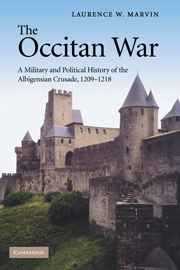Book contents
- Frontmatter
- Contents
- List of abbreviations
- List of maps and plans
- Translation of names and places; calculation of distances
- Preface and acknowledgments
- Maps and plans
- 1 Introduction
- 2 The campaign of 1209
- 3 Simon of Montfort and the campaign of 1210
- 4 The campaigns of 1211
- 5 Drawing the noose: the campaign year of 1212
- 6 The athlete of Christ triumphs: late 1212 through Muret 1213
- 7 From Muret to Casseneuil: September 1213 to December 1214
- 8 The two councils and Prince Louis's crusade, January–December 1215
- 9 The southern counter-attack begins: February 1216 to fall 1217
- 10 The second siege of Toulouse and end of the chief crusader: 1217–1218
- Aftermath and epilogue
- Select bibliography
- Index
7 - From Muret to Casseneuil: September 1213 to December 1214
Published online by Cambridge University Press: 18 July 2009
- Frontmatter
- Contents
- List of abbreviations
- List of maps and plans
- Translation of names and places; calculation of distances
- Preface and acknowledgments
- Maps and plans
- 1 Introduction
- 2 The campaign of 1209
- 3 Simon of Montfort and the campaign of 1210
- 4 The campaigns of 1211
- 5 Drawing the noose: the campaign year of 1212
- 6 The athlete of Christ triumphs: late 1212 through Muret 1213
- 7 From Muret to Casseneuil: September 1213 to December 1214
- 8 The two councils and Prince Louis's crusade, January–December 1215
- 9 The southern counter-attack begins: February 1216 to fall 1217
- 10 The second siege of Toulouse and end of the chief crusader: 1217–1218
- Aftermath and epilogue
- Select bibliography
- Index
Summary
In the wake of the Aragonese-Occitan defeat at Muret, one might have expected the chief crusader to take the offensive and attack Toulouse directly before the end of the year. On the contrary, in 1213 Montfort made no moves against the city. Even though militarily Toulouse had suffered a grievous blow by losing so many of its able-bodied militiamen at Muret, the city possessed strong walls and its inhabitants still harbored an intense hatred for Simon of Montfort. Taking the city would not have been easy, as events in the summer of 1211 had shown. Just as importantly, Muret had occurred late in the campaign season. Montfort's army was too small for the size and complexity a siege of Toulouse would entail, and he could not count on many reinforcements until the following spring. Even a summer campaign for 1214 was in doubt, since there was no indulgence for outsiders as per Innocent's letter of the preceding spring. In spite of his triumph at Muret, then, to attack Toulouse would be folly, so Montfort did not try it.
Instead, the seven bishops and three abbots with the army at Muret believed that the citizens of Toulouse would now be more amenable to reconciliation after such an obvious sign of God's disfavor towards them. The prelates determined to reconcile the Toulousans to the church, probably based on instructions sent to the late Pere II and Folquet of Marseille on 21 May 1213.
- Type
- Chapter
- Information
- The Occitan WarA Military and Political History of the Albigensian Crusade, 1209–1218, pp. 196 - 216Publisher: Cambridge University PressPrint publication year: 2008



